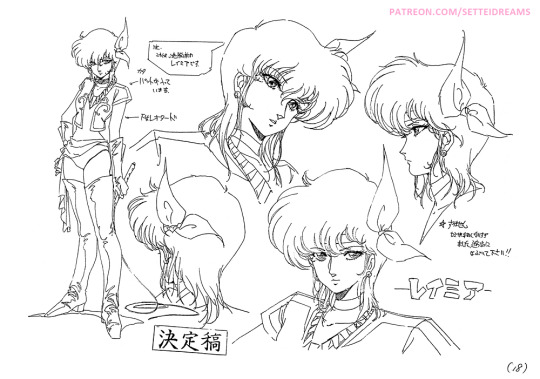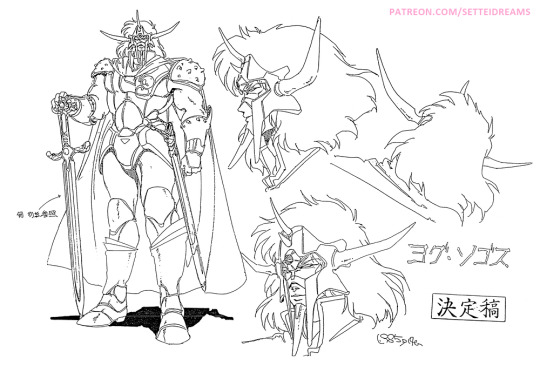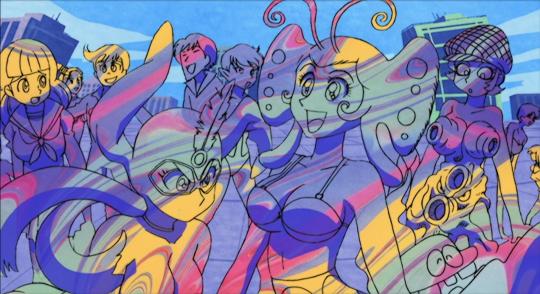#mujigen hunter fandora
Explore tagged Tumblr posts
Text

#Mujigen Hunter Fandora#Dream-Dimension Hunter Fandora#Go Nagai#Wasteland Travel#Anime Speeder#Relaxing Trip#Anime#Anime GIF#My GIFs
3 notes
·
View notes
Text



✿ Mujigen Hunter Fandora ┊ 53 sheets ✿
… a 1985 OVA with character designs by Hideki Tamura, Mayumi Watanabe, Hideko Yamauchi and Takahiro Toyomasu has been added to Patreon.
#mujigen hunter fandora#anime#animation#retro#retro anime#80s anime#model sheets#character design#character sheets#settei#art reference#reference
15 notes
·
View notes
Text



Cel of Fandora
From the first OVA of Mujigen Hunter Fandora / Dream Dimension Hunter Fandora / 夢次元ハンターファンドラ
The bag of chips was redone from the image on the right to the image on the left, which is what you see on screen in the scene added
The top image was a scan.
#Fandora#Dream Dimension Hunter Fandora#Mujigen Hunter Fandora#夢次元ハンターファンドラ#Anime Cel#Animation Cel#80s Anime
3 notes
·
View notes
Photo

Mujigen Hunter Fandora
Genre : sci-fi, fantasy, adventure, ecchi
Category : OVA
Episodes : 3 duration 40 min
#Mujigen Hunter Fandora#Dream Dimension Hunter Fandora#anime#retro anime#anime 80s#anime ova#anime fantasy#anime sci-fi#anime adventure
20 notes
·
View notes
Photo

Dream Dimension Hunter Fandora - illustration by Mayumi Watanabe
6 notes
·
View notes
Photo










#vintage anime#retro anime#screencap#background#80s anime#aesthetic#anime aesthetic#animecore#fandora#夢次元ハンター ファンドラ#mujigen hunter fandora#Dream dimension Hunter Fandora
41 notes
·
View notes
Photo

6 notes
·
View notes
Photo

64 notes
·
View notes
Photo

12 notes
·
View notes
Photo

1 note
·
View note
Text
Mahou Ningyou Pendora
One of the interesting things about focusing just on manga that don't have anime is there are certain story concepts that show up here, but nowhere else. I can't think of many, or indeed any, magical girl anime that focus on magical dolls with an average girl as the audience insert character. (Doesn't mean they don't exist; I just can't think of any right now.) However; if I had a nickel for every time I found an old magical girl manga about a little girl who has a doll that is both alive and magical, I'd have two nickels, which isn't a lot but it's weird that it happened twice, right?

Mahou Ningyou Pendora (Magic Doll Pendora) is a 1981 manga starring a prim and proper little girl named Youko-chan. One day Youko gets caught out in the rain and finds a doll on the side of the road. The doll isn't in great condition, but Youko takes her home anyway and cleans her up. This doll then comes alive and grows to the size of an adult woman, introducing herself as Pendora. For the first leg of the series, Pendora uses her magic to make life more fun for Youko and protect her from harm. However, chapter 6 introduces two new characters who act as foils to Youko and Pendora. Kenbo (usually referred to as Itazura Kenbo, with Itazura meaning naughty) is a boy Youko's age who lives up to his nickname, and he has a magic doll of his own named Kabutler. From there, the series mostly revolves around Kenbo and Kabutler pranking Youko and Pendora, with Pendora swiftly delivering the two their comeuppance.
If you read my post about Majokko Lily, parts of this setup probably sound familiar. Both Lily and Pendora disguise themselves as dolls when not actively using magic, and the POV character is the human girl. I'm not sure how much of this was intentional vs. coincidence; but either way, there are a couple of key differences that set these manga apart. While Deko is able to use Lily's magic at times, Youko is never able to do the same with Pendora's magic. The more major difference is the introduction of antagonist characters Kenbo and Kabutler, who don't really have an analogue in Majokko Lily.

Design-wise, Mahou Ningyou Pendora is somewhat interesting to me as well. Pendora and Kabutler have a bug motif, with Pendora based on butterflies and Kabutler based on stag beetles. The wings on Pendora's head remind me of the distinctive butterfly hair of a later magical girl known as Yadamon, though their pink color is also evocative of Nemulin. Pendora has a magic wand, though she rarely uses it. Like many other early magical girls, she can conjure magic with just her hands, and she has heightened physical strength that comes in handy too.
Mahou Ningyou Pendora was published in Yoiko from the April 1981 issue to the August 1982 issue for a total of 17 chapters, each 4 or 5 pages long. These chapters were never reprinted outside of the original magazine run, and as far as I can tell they've never been translated either.
The series was created by Go Nagai through his studio, Dynamic Productions. Nagai is a mangaka who has been hugely influential in the history of not only the magical girl genre, but broader manga and anime history as well. He made his debut in 1967 with Meakashi Polikichi, and he would really make a name for himself in shounen manga/anime throughout the 70s. Arguably his biggest contributions were to the mecha genre with titles such as Koutetsu Jeeg, UFO Robo Grendizer, and Mazinger Z, the lattermost of which was the first series to feature a giant robot piloted by a person. His are credited as some of the first post-apocalyptic manga, beginning with his series Violence Jack, and Nagai's works are generally known for their dark tone, such as his subversive hero series, 1972's Devilman, which was also the first manga of his to get animated. Other Nagai anime include Dororon Enma-kun, Mujigen Hunter Fandora, and Juushin Liger. Not only that, but his work continues to be rebooted, the most recent example being 2021's Getter Robo Arc. Many other influential figures in anime and manga have cited Nagai's work as among their influences, including but by no means limited to Hideaki Anno, Kentarou Miura, and Gen Urobuchi.
When it comes to magical girls however, Nagai's best known creation is Cutie Honey. The original anime and manga were created in tandem with one another, and the series would be the first male-aimed magical girl work in both mediums. The 1973 Cutie Honey anime was the first magical girl warrior anime, which would directly influence later titles in the sub-genre up to and including Sailor Moon. Like Nagai's other works, Cutie Honey would be rebooted many a time, most recently as a 2020 stage play titled Cutie Honey Emotional.
While shoujo manga reimaginings of Cutie Honey were created alongside the original, Go Nagai wouldn't make a fully shoujo magical girl of his own until 1978 with Majokko Tickle. Cutie Honey and Majokko Tickle contrast in some interesting ways. The former had little in common with other magical girl anime of the time, but has a fair degree of overlap with modern expectations of magical girls. The latter was more in line with magical girl archetypes of the 70s, but bears little resemblance to how people think of the genre currently. It's unsurprising then that Cutie Honey has endured the test of time while Majokko Tickle has all but fallen into obscurity, even in Japan.
The magical girl stuff isn't the only connection Mahou Ningyou Pendora has to Nagai's legacy, but the other point of overlap is more... uncomfortable. Nagai is a legendarily horny dude, so much so that he's credited with pioneering ecchi as a genre. While one would hope this sort of content wouldn't make it into a manga for an audience as young as this, there are times when Mahou Ningyou Pendora certainly looks like a Nagai manga let's say. Pendora's default outfit is quite formfitting, a common staple of Nagai's heroine's character designs. Granted, that isn't inherently erotic, and if I didn't know who Nagai is, it might not even register. However, there's also a chapter where the characters make a trip to the beach and we get to see Pendora in a somewhat skimpy bikini. To be honest, I don't totally mind this because Pendora is a grown woman who can wear what she wants. There's certainly a conversation to be had about how much agency a fictional woman has in a story created by a man, but we don't have time for that conversation here. What does bother me is how often Youko is shown partially or fully nude, including in the very first chapter. Thankfully she has Barbie doll anatomy, so it isn't exactly obscene, but I still question if it was necessary.

Interestingly enough, Pendora (or at least her doppelgänger) has appeared elsewhere within Go Nagai's body of work. Her design was initially used for the character of Kochou Phantasy in Nagai's 1978 manga Space Opera Chugaku (content warning for female-presenting nipples) and she would make a cameo alongside other Nagai characters in the first episode of the 2004 OVA Re: Cutie Honey.
I love the concept underpinning this manga, and I feel like a lot could have been done with it, but I also feel as though the premise was hampered by the demographic. However good the core ideas are, this is very clearly a manga for kindergarteners, which makes it difficult to get too invested as an adult reader. The only times the manga breaks from this mold are when it's being horny, and in the context of everything else, I don't care for that either. It's not a bad manga by any means, but it's just not on par with Nagai's other, more well-known magical girls.
#my posts#long post#Mahou Ningyou Pendora#魔法にんぎょうペンドラ#Go Nagai#永井豪#Yoiko#80s#shoujo#content warning: lolicon#<- not exactly sure if the stuff with Youko counts but I'd rather not catch anybody off guard
20 notes
·
View notes
Text

#Mujigen Hunter Fandora#Dream-Dimension Hunter Fandora#Wrestling in Anime#Ankle Scissor#WWE#AEW#TNA Wrestling#Anime#Anime GIF#My GIFs
0 notes
Photo










#vintage anime#retro anime#screencap#background#80s anime#aesthetic#anime aesthetic#animecore#fandora#夢次元ハンター ファンドラ#mujigen hunter fandora#Dream dimension Hunter Fandora
26 notes
·
View notes
Photo

41 notes
·
View notes
